AUGMENTIN® (Amoxicillin / Clavulanic Acid) 875 mg/125 mg, 14 film-coated tablets
$29.70
Description
One tablet contains
Active Ingredients:
- Amoxicillin (as amoxicillin trihydrate) 875 mg;
- Clavulanic acid (as potassium clavulanate) 125 mg
- Excipients: magnesium stearate, sodium starch glycolate type A, colloidal anhydrous silicon dioxide, microcrystalline cellulose,
- the rest of the shell: titanium dioxide (E 171), hypromellose (5 cps), hypromellose (15 cps), macrogol 4000, macrogol 6000, silicone oil (dimethicone 500).
Pharmacological properties
Pharmacokinetics
Suction
Amoxicillin and clavulanate are highly soluble in aqueous solutions at physiological pH, both substances are rapidly and completely absorbed from the gastrointestinal tract after oral administration. The absorption of amoxicillin and clavulanic acid is optimal when the drug is taken at the beginning of a meal. After taking the drug inside, its bioavailability is 70%. The profiles of both components of the drug are similar and reach peak plasma concentration (Tmax) in about 1 hour. The concentration of amoxicillin and clavulanic acid in the blood serum is the same both in the case of the combined use of amoxicillin and clavulanic acid, and each component separately.
Distribution
Plasma protein binding of amoxicillin and clavulanic acid is moderate: 25% for clavulanic acid and 18% for amoxicillin. The apparent volume of distribution is about 0.3-0.4 l/kg for amoxicillin and about 0.2 l/kg for clavulanic acid.
After intravenous administration, therapeutic concentrations of amoxicillin and clavulanic acid are achieved in various organs and tissues, interstitial fluid (lungs, abdominal organs, gallbladder, adipose, bone and muscle tissues, pleural, synovial and peritoneal fluids, skin, bile, purulent discharge , sputum). Amoxicillin and clavulanic acid practically do not penetrate into the cerebrospinal fluid.
Amoxicillin, like most penicillins, is excreted in breast milk. Trace amounts of clavulanic acid have also been found in breast milk. Except for the risk of sensitization, amoxicillin and clavulanic acid do not adversely affect the health of breastfed infants. Amoxicillin and clavulanic acid cross the placental barrier.
Metabolism
Amoxicillin is partially excreted in the urine as inactive penicillic acid in an amount equivalent to 10-25% of the dose taken. Clavulanic acid is extensively metabolized in the body and is excreted in urine and feces, as well as in the form of carbon dioxide through exhaled air.
Elimination
Amoxicillin is excreted primarily by the kidneys, while clavulanic acid is eliminated via both renal and extrarenal mechanisms. After a single oral administration of one tablet of 250 mg / 125 mg or 500 mg / 125 mg, approximately 60-70% of amoxicillin and 40-65% of clavulanic acid are excreted unchanged in the urine during the first 6 hours.
Various studies have confirmed that urinary excretion is 50-85% for amoxicillin and 27-60% for clavulanic acid within 24 hours. With regard to clavulanic acid, the maximum amount is excreted within the first 2 hours after ingestion.
Concomitant use of probenecid slows down the renal excretion of amoxicillin, but does not slow down the renal excretion of clavulanic acid.
Pharmacodynamics
Augmentin® is a combination antibiotic containing amoxicillin and clavulanic acid, with a broad spectrum of bactericidal action, resistant to beta-lactamase.
Amoxicillin is a semi-synthetic antibiotic (beta-lactam), with a broad spectrum of action, active against many gram-positive and gram-negative microorganisms.
The bactericidal mechanism of action of amoxicillin is to inhibit the biosynthesis of peptidoglycans of the bacterial cell wall, which leads to lysis and death of the bacterial cell.
Amoxicillin is susceptible to degradation by beta-lactamase produced by resistant bacteria, and therefore the spectrum of activity of amoxicillin alone does not include microorganisms that produce these enzymes.
Clavulanic acid is a beta-lactamate, similar in chemical structure to penicillins, which has the ability to inactivate the beta-lactamase enzymes of microorganisms that are resistant to penicillins and cephalosporins, thereby preventing the inactivation of amoxicillin. Beta-lactamases are produced by many Gram-positive and Gram-negative bacteria. Clavulanic acid blocks the action of enzymes, restoring the sensitivity of bacteria to amoxicillin. In particular, it has high activity against plasmid beta-lactamases, which are often associated with drug resistance, but is less effective against type 1 chromosomal beta-lactamases.
The presence of clavulanic acid in the composition of Augmentin® protects amoxicillin from the destructive action of beta-lactamases and expands its spectrum of antibacterial activity to include microorganisms that are usually resistant to other penicillins and cephalosporins. Clavulanic acid in the form of a single drug does not have a clinically significant antibacterial effect.
Mechanism of development of resistance
There are 2 mechanisms for the development of resistance to Augmentin®:
– inactivation by bacterial beta-lactamases that are insensitive to the effects of clavulanic acid, including classes B, C, D
– deformation of the penicillin-binding protein, which leads to a decrease in the affinity of the antibiotic in relation to the microorganism
The impermeability of the bacterial wall, as well as pumping mechanisms, can cause or contribute to the development of resistance, especially in gram-negative organisms.
Augmentin® has a bactericidal effect on the following microorganisms:
Gram-positive aerobes: Bacillius anthracis, Enterococcus faecalis, Gardnerella vaginalis, Listeria monocytogenes, Nocardia asteroides, Staphylococcus aureus (methicillin-sensitive), coagulase-negative staphylococci (methicillin-sensitive), Streptococcus agalactiae, Streptococcus pneumoniae1, Streptococcus pyogenes and other beta-hemolytic bacteria , Streptococcus viridans group,
Gram-negative aerobes: Actinobacillus actinomycetemcomitans, Capnocytophaga spp., Eikenella corrodens, Haemophilus influenzae, Moraxella catarrhalis, Neisseria gonorrhoeae, Pasteurella multocida
anaerobic microorganisms: Bacteroides fragilis, Fusobacterium nucleatum, Prevotella spp.
Microorganisms with possible acquired resistance
Gram-positive aerobes: Enterococcus faecium*
Gram-negative aerobes: Escherichia coli, Klebsiella oxytoca, Klebsiella pneumoniae, Proteus mirabilis, Proteus vulgaris
Microorganisms with natural resistance:
gram-negative aerobes: Acinetobacter species, Citrobacter freundii, Enterobacter species, Legionella pneumophila, Morganella morganii, Providencia species, Pseudomonas species, Serratia species, Stenotrophomonas maltophilia;
others: Chlamydia trachomatis, Chlamydophila pneumoniae, Chlamydophila psittaci, Coxiella burnetti, Mycoplasma pneumoniae.
1 With the exception of strains of Streptococcus pneumoniae resistant to penicillins
* Natural sensitivity in the absence of acquired resistance
Indications for use
– Acute bacterial sinusitis (with confirmed diagnosis)
– acute inflammation of the middle ear (acute otitis media)
– exacerbation of chronic bronchitis (with a confirmed diagnosis)
– community-acquired pneumonia
– urinary tract infections (cystitis, pyelonephritis)
– infections of the skin and soft tissues (in particular, cellulitis, animal bites, acute abscesses and phlegmon of the maxillofacial region)
– infections of the bones and joints (particularly osteomyelitis)
Official recommendations on the appropriate use of antibacterial agents should be taken into account.
Dosage and administration
Sensitivity to Augmentin® may vary by geographic location and time. Before prescribing the drug, if possible, it is necessary to assess the sensitivity of strains in accordance with local data and determine the sensitivity by taking and analyzing samples from the individual patient, especially in case of severe infections.
Augmentin® can be used to treat infections caused by amoxicillin-susceptible microorganisms and mixed infections caused by amoxicillin- and clavulanate-susceptible beta-lactamase producing strains.
The dosage regimen is set individually depending on age, body weight, kidney function, infectious agents, as well as the severity of the infection.
To reduce the potential risk of affecting the gastrointestinal tract, Augmentin® is recommended to be taken with food, at the beginning of a meal for maximum absorption. The duration of therapy depends on the patient’s response to the treatment. Some pathologies (particularly osteomyelitis) may require a longer course. Treatment should not be continued for more than 14 days without reassessment of the patient’s condition. If necessary, it is possible to carry out stepwise therapy (initially, intravenous administration of the drug, followed by the transition to oral administration).
Adults and children over 12 years of age or weighing more than 40 kg
Mild to moderate infection (standard dose)
1 tablet 500 mg/125 mg 2-3 times a day or 1 tablet 875 mg/125 mg 2 times a day
Severe infections (otitis media, sinusitis, lower respiratory infections, urinary tract infections)
1-2 tablets 500 mg/125 mg 3 times a day or 1 tablet 875 mg/125 mg 2 or 3 times a day
The maximum daily dose for adults and children over 12 years of age using 500 mg / 125 mg tablets is 1500 mg amoxicillin / 375 mg clavulanic acid. For tablets with a dosage of 875 mg / 125 mg, the maximum daily dose is 1750 mg amoxicillin / 250 mg clavulanic acid (when taken 2 times a day) or 2625 mg amoxicillin / 375 mg clavulanic acid (when taken 3 times a day).
Children under 12 years of age or weighing less than 40 kg
This dosage form is not intended for children under 12 years of age or children weighing less than 40 kg. Such children are prescribed Augmentin® in the form of a suspension for oral administration.
Patients with impaired renal function
Dose adjustments are based on the maximum recommended dose of amoxicillin and creatinine clearance.
adults
Creatinine clearance
Dosing regimen of Augmentin®
>30 ml/min
Dose adjustment is not required
10-30 ml/min
1 tablet 500 mg/125 mg 2 times a day
< 10 ml/min
1 tablet 500 mg/125 mg 1 time per day
Tablets with a dosage of 875 mg / 125 mg should only be used in patients with creatinine clearance > 30 ml / min.
Patients on hemodialysis
Dose adjustments are based on the maximum recommended dose of amoxicillin.
Adults: 1 tablet 500 mg/125 mg every 24 hours. An additional 1 dose during the dialysis session and another dose at the end of the dialysis session (to compensate for the decrease in serum concentrations of amoxicillin and clavulanic acid) is prescribed.
Tablets with a dosage of 875 mg / 125 mg should only be used in patients with creatinine clearance > 30 ml / min.
Patients with impaired liver function
Treatment is carried out with caution; regularly monitor liver function.
Elderly patients
It is not necessary to reduce the dose of Augmentin; doses are the same as for adults. In elderly patients with impaired renal function, the dose should be adjusted as indicated above for adults with impaired renal function.
Side effects
Side effects observed in clinical studies and in the post-marketing period are presented below and are listed depending on the anatomical and physiological classification and frequency of occurrence.
The frequency of occurrence is defined as follows: very often (≥1/10), often (≥1/100 and <1/10), infrequently (≥1/1000 and <1/100), rare (≥1/10000 and <1/1,000), very rare (<1/10,000, including isolated cases), not known (frequency cannot be determined from the available data).
Often
– candidiasis of the skin and mucous membranes
– nausea, vomiting, diarrhea
Nausea is more common with high doses of the drug. To reduce the degree of manifestation, it is recommended to take the suspension at the beginning of a meal.
Infrequently
– dizziness, headache
– dyspepsia
– Moderate elevation of liver enzymes ALT/AST
– skin rash, itching, hives
Rarely
– reversible leukopenia (including neutropenia)
– thrombocytopenia
– erythema multiforme
Rarely
– antibiotic-associated colitis (including pseudomembranous and hemorrhagic)
– black hairy tongue (chronic hyperplasia of the filiform papillae of the tongue)
– reversible surface staining of tooth enamel (easily removed by brushing). Good oral hygiene helps prevent staining of tooth enamel.
unknown
– rapid growth of non-susceptible organisms
– reversible agranulocytosis
– hemolytic anemia
– increase in bleeding time and prothrombin time index
– angioedema, anaphylaxis
– a syndrome similar to serum sickness
– allergic vasculitis
– reversible increased activity
– convulsions
– hepatitis, cholestatic jaundice
– Stevens-Johnson syndrome
– toxic epidermal necrolysis
– exfoliative bullous dermatitis, acute generalized exanthematous pustulosis. With the development of these symptoms, the drug should be discontinued.
– interstitial nephritis, crystalluria
Contraindications
– known hypersensitivity to penicillins or to any component of the drug
– known hypersensitivity to other beta-lactam antibiotics (cephalosporins, carbapenems, monobactams)
– jaundice or abnormal liver function that developed while taking a combination of amoxicillin / clavulanic acid
– children under 12 years of age or children weighing less than 40 kg
Drug Interactions
It is not recommended to use Augmentin® simultaneously with probenecid. Probenicid reduces the tubular secretion of amoxicillin, and therefore the simultaneous use of Augmentin® and probenecid can lead to an isolated increase in the blood level of amoxicillin.
The simultaneous use of allopurinol and Augmentin® may increase the risk of allergic reactions. Data on the simultaneous use of allopurinol and Augmentin® are currently not available.
Augmentin® affects the intestinal flora and leads to a decrease in estrogen reabsorption and a decrease in the effectiveness of combined oral contraceptives.
Cases of an increase in prothrombin time (acenocoumarol and warfarin) have been identified with the simultaneous use of Augmentin® and anticoagulants, it is necessary to conduct appropriate monitoring with dose adjustment of Augmentin® if necessary.
Penicillins can reduce the excretion of methotrexate, which is a potential risk of increasing its toxicity.
In patients taking mycophenolate mofetil, when used together with Augmentin®, the concentration of the active metabolite of mycophenolic acid at the initial dose is reduced by approximately 50%. Changes in initial dose concentrations may not be consistent with changes in total mycophenolic acid exposure. However, clinical monitoring is recommended for patients taking mycophenolate mofetil simultaneously with Augmentin or immediately after taking the antibiotic.
Special instructions
Before starting treatment with Augmentin, it is necessary to collect a detailed history regarding previous hypersensitivity reactions to penicillins, cephalosporins or other beta-lactam antibiotics.
Serious and sometimes fatal hypersensitivity reactions (anaphylactic shock) to penicillins have been described, more often in patients with previous hypersensitivity to penicillins. In the event of an allergic reaction, it is necessary to stop treatment with Augmentin® and start alternative therapy. With the development of serious hypersensitivity reactions, adrenaline should be administered to the patient immediately. Oxygen therapy, intravenous steroids, and airway management, including intubation, may be required.
Augmentin® should not be prescribed if infectious mononucleosis is suspected, because in patients with this disease, amoxicillin can cause a skin rash, which makes it difficult to diagnose the disease.
Long-term treatment with Augmentin® may be accompanied by excessive growth of microorganisms insensitive to it.
Cases of pseudomembranous colitis have been identified with antibiotic use, the severity of which ranged from mild to severe, life-threatening patients. Thus, it is necessary to keep in mind the possibility of this pathology in patients with diarrhea while taking antibiotics or after the end of the course of therapy. In the event of the development of prolonged or significant diarrhea, in the presence of cramps in the abdomen, treatment with Augmentin® should be immediately discontinued and patients should be referred for further examination.
In general, Augmentin® is well tolerated and has a low toxicity characteristic of all penicillins. With prolonged treatment with Augmentin®, it is recommended to periodically evaluate the functions of the kidneys, liver, and hematopoietic organs.
In patients receiving Augmentin®, an increase in prothrombin time is occasionally observed, therefore, with the simultaneous use of Augmentin® and anticoagulants, appropriate monitoring should be carried out with a possible reduction in the dose of the anticoagulant, if necessary.
Augmentin® should be used with caution in patients with impaired liver function. Signs and symptoms of liver damage usually occur during or immediately after the start of treatment, but in some cases may not appear for several weeks after stopping therapy. As a rule, they are reversible. Hepatic impairment can be very serious, and death has been reported in extremely rare cases. They have almost always been reported in patients with a serious underlying disease or in those who were concomitantly taking drugs known to potentially affect the liver.
In patients with renal insufficiency, the dose of the drug should be adjusted according to the severity of the disease.
When prescribing the drug to patients with reduced renal function or when using high doses, seizures may develop.
Rarely, crystalluria may occur in patients with reduced diuresis. During the administration of high doses of amoxicillin, it is recommended to take a sufficient amount of fluid and maintain adequate diuresis to reduce the likelihood of amoxicillin crystal formation. Patients with a catheter need constant evaluation of their condition.
The combined use of allopurinol and amoxicillin increases the likelihood of skin allergic reactions.
During treatment with amoxicillin, enzymatic glucose oxidation methods should be used to determine the content of glucose in the urine, since non-enzymatic methods can lead to false positive results.
The presence of clavulanic acid in Augmentin® can cause non-specific binding of IgG and albumin to the erythrocyte membrane, which leads to a false positive Coombs reaction.
Pregnancy and lactation
Augmentin® is not recommended for use during pregnancy, unless, in the opinion of a physician, it is necessary.
Augmentin® can be administered while breastfeeding. With the exception of the risk of sensitization due to trace amounts of the drug that passes into breast milk, no adverse effects have been identified in breast-fed children.
In women with preterm rupture of membranes and preterm birth, it was found that prophylactic treatment with a combination of amoxicillin and clavulanate was associated with an increased risk of developing necrotizing enterocolitis in newborns.
Features of the influence of the drug on the ability to drive a vehicle or potentially dangerous mechanisms
There is no data; however, due to the possibility of adverse reactions (dizziness, convulsions), care must be taken.
Overdose
Symptoms: gastrointestinal disturbances and disturbances in water and electrolyte balance are possible. Amoxicillin crystalluria has been described, in some cases leading to the development of renal failure.
When prescribing the drug to patients with reduced renal function or when using high doses, seizures may develop.
Precipitation of amoxicillin on vesical catheters is possible, especially after administration of high doses by intravenous administration.
Treatment: symptomatic therapy, correction of water and electrolyte balance. Augmentin® is removed from the blood by hemodialysis.
Storage conditions
Store at a temperature not exceeding 25 ºС.
Keep out of the reach of children.
Shelf life 3 years
Do not use after the expiration date.





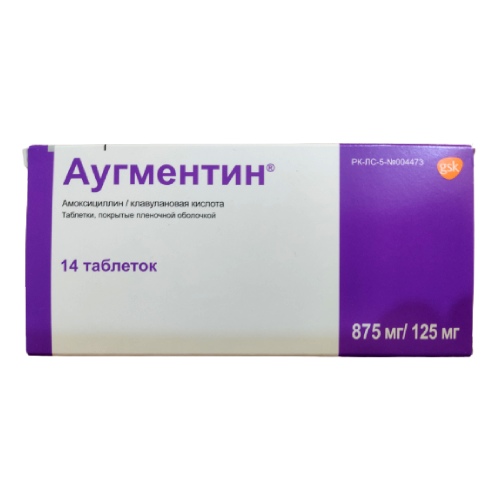

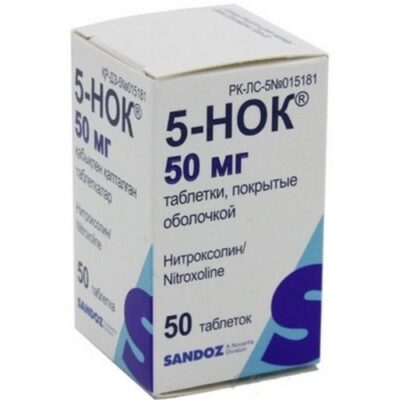
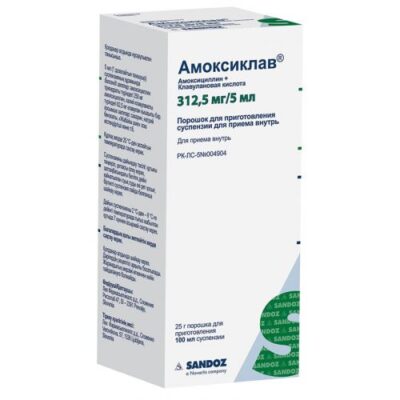
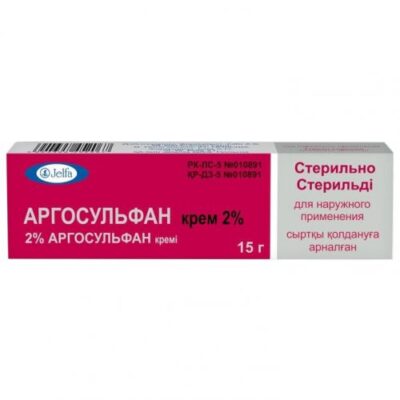
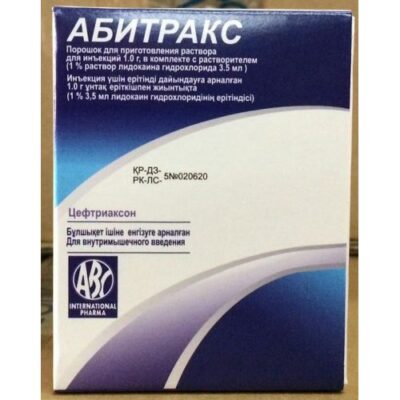
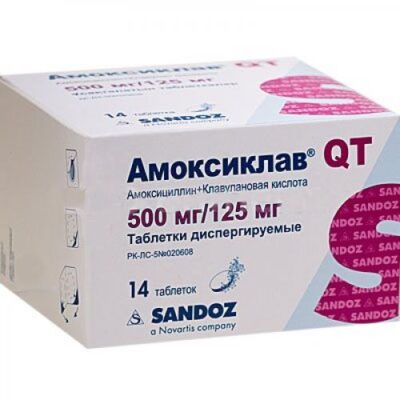
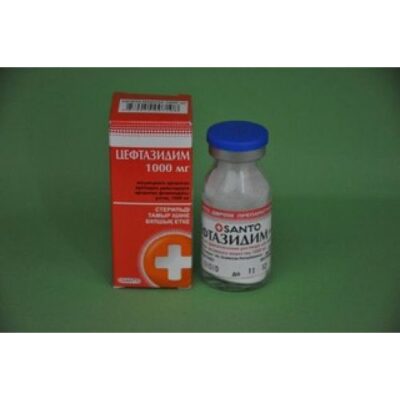

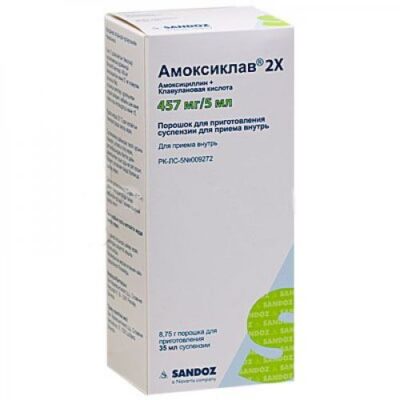
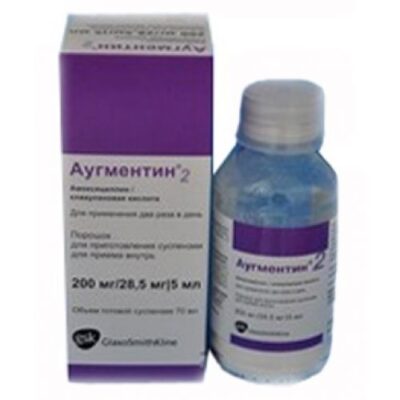






Reviews
There are no reviews yet.